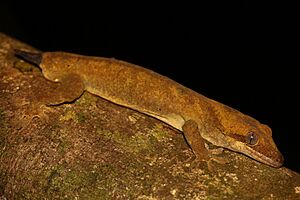Correlophus sarasinorum facts for kids
Quick facts for kids Correlophus sarasinorum |
|
|---|---|
 |
|
| Conservation status | |
| Scientific classification | |
| Genus: |
Correlophus
|
| Species: |
sarasinorum
|
| Synonyms | |
|
|
The Roux's giant gecko, also known as the Sarasins' giant gecko or suras gecko, is a type of lizard. Its scientific name is Correlophus sarasinorum. This gecko belongs to the family called Diplodactylidae. It naturally lives in the southern parts of Grande Terre, an island that is part of New Caledonia.
Contents
What's in a Name?
The scientific name sarasinorum was given to honor two Swiss zoologists, Karl Friedrich Sarasin and Paul Benedict Sarasin. They were cousins who studied animals.
Protecting This Gecko
The Correlophus sarasinorum is currently being looked at by CITES for special protection. Many experts who study reptiles and amphibians (called herpetologists) believe it is vulnerable to extinction. This means it could disappear forever if we don't protect it. So far, this gecko has only been found in six different places in its natural home.
What Does It Look Like?
The Roux's giant gecko can be different sizes. Its body length, from snout to the base of its tail, can be anywhere from 3.5 to 5.5 inches (9 to 14 centimeters). Because of this size difference, some scientists think there might be more than one kind of Correlophus sarasinorum.
The main color of this gecko is usually brown or gray. They can have two main patterns:
- One pattern has white spots. This is a recessive trait, meaning it's less common.
- The other pattern has a white "V" shape. This is a dominant trait, so it's seen more often.
Many people say this gecko looks like a bigger version of the Correlophus ciliatus, which is also known as the crested gecko. The Roux's giant gecko has larger eyes compared to the crested gecko.
Where It Lives
The Correlophus sarasinorum prefers to live in natural habitats like forests and shrublands. You can find them at different heights, from about 65 feet (20 meters) to 1,970 feet (600 meters) above sea level.
How It Behaves
This gecko is nocturnal, which means it is active at night. During the day, it often hides. You might find it under leaf litter (fallen leaves and twigs) or under loose tree bark. Unlike some other geckos, it doesn't spend as much time high up in trees.
Interestingly, these geckos often sleep on top of plants or in small trees with their face pointing upwards. This helps them avoid something called FTS (Floppy Tail Syndrome). This syndrome can happen if the gecko sleeps upside down, which can cause its tail to become floppy.
What It Eats
The Correlophus sarasinorum is an omnivore, meaning it eats both plants and animals. It is also considered frugivorous, which means it loves to eat fruit. In the wild, its diet includes insects and various fruits.
How It Reproduces
Female Correlophus sarasinorum geckos lay two eggs at a time. They bury these eggs in soft, damp soil or other material. After the eggs are laid, it takes about 60 to 90 days for them to hatch.
Keeping Them as Pets
Sometimes, you can find the Correlophus sarasinorum species kept by people as pets.


